| |
|
42.
 | Roots 03
| Roots 03 |
| |

“The three-part work Roots reveals a drawing made of antenna cables. The pattern seen is reminiscent of Arab-Islamic Art that has developed throughout history in the field of abstraction as religion forbade the representation of the human figure.
Nevertheless, this work is a tribute to the architect, the handyman, and to all the anonymous individuals that create the status quo.”
Anti-utopias, January, 2017
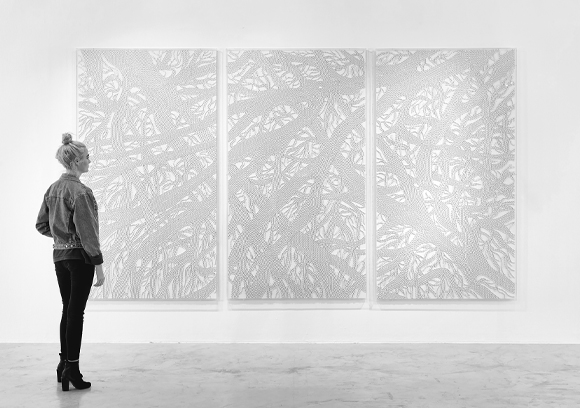
Roots 01
Exhibition view from Fragmented Memory, Goodman Gallery, 2017, Johannesburg.
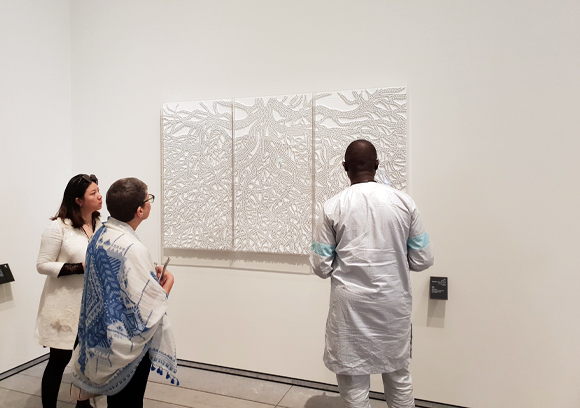
Roots 02
Exhibition view from Abu Dhabi Museum opening, 2017, Abu Dhabi.

Roots 03
Exhibition view from Survival Signs, Jane Lombard, 2017, New York.
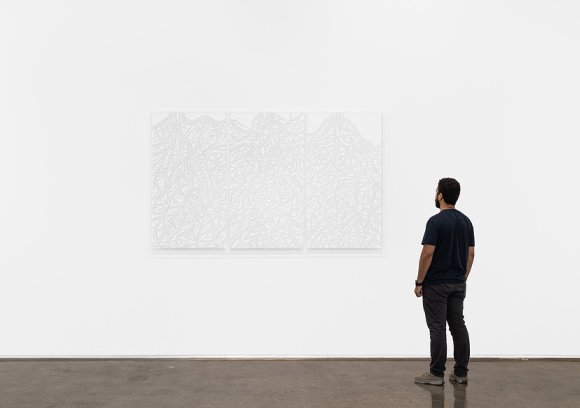
Roots 03
Exhibition view from Whispered Stories of Forgotten Wires, Piero Atchugarry Gallery, 2023, Miami.
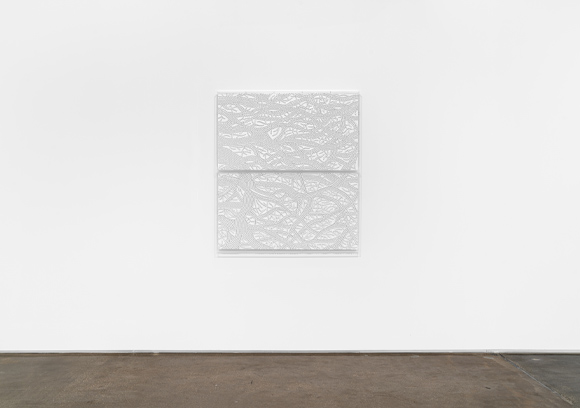
Roots 04
Exhibition view from Whispered Stories of Forgotten Wires, Piero Atchugarry Gallery, 2023, Miami.
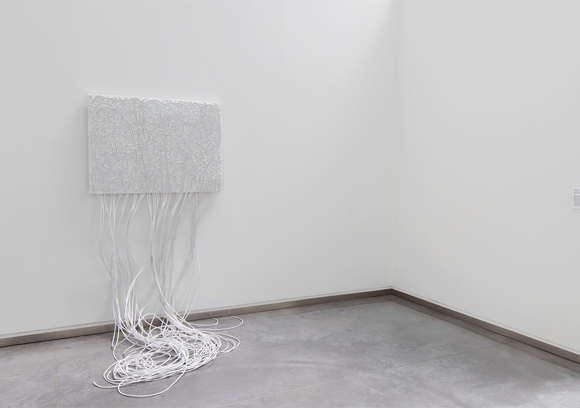
Roots 08
Exhibition view from The Day of the Awakening, CDAN, 2018, Huesca.
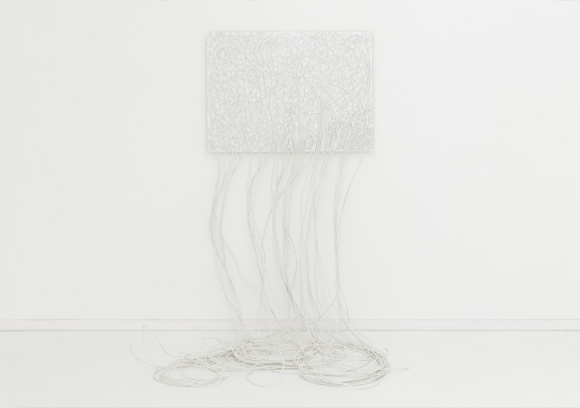
Roots 08
Exhibition view from The Observer Effect, ADN, 2021, Barcelona.
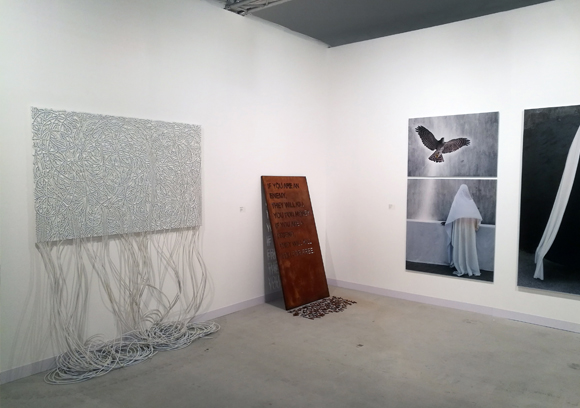
Roots 10
Exhibition view from Abu Dhabi Art Fair, 2019, Abu Dhabi.
|
|
2015-2016, triptych, coaxial antenna cable and staples, 120 x 65 cm each.
Exhibition view from Survival Signs, Jane Lombard, 2017, New York.
Courtesy of the artist and Piero Atchugarry, Miami.
|
|
|
| Collection of Louvre Abu Dhabi, Abu Dhabi
Collection of King Abdulaziz Center for World Culture - Ithra, Dhahran
La première chose qu’on peut dire de la sculpture racines de mounir fatmi : c’est qu’elle est complexe. Complexe par la technique que l’artiste utilise depuis l998 qui consiste à faire des bas reliefs avec des câbles blancs d’antennes. Ce matériau utilisé depuis la création de la télévision pour relier une antenne à un téléviseur et diffuser des images, constitue la base première de l’œuvre.
Ce câble d’antenne devient en même temps une archive précieuse puisque c'est un matériau en voie de disparition. Ainsi l’œuvre et son archive se trouvent au même niveau et crée un dialogue. L’archive crée l’œuvre et l’œuvre conserve l’archive.
La complexité de l'œuvre s'explique par les liens qu'elle tisse entre plusieurs éléments d'inspiration. On retrouve ainsi l’ornementation de l’art arabo-musulman et le all-over. On peut aussi percevoir l'influence de certaines peintures dripping de Jackson Pollock, figures à laquelle l'artiste a déjà rendu hommage à travers la série rencontres en 2010 et la grande sculpture de câbles connexions exposée au Musée des Arts Décoratifs à Paris en 1999.
A première vue, l'œuvre paraît très esthétique. Cependant, elle tente de répondre à une question philosophique transversale posée par l'artiste : jusqu’à quelle profondeur les racines s’enfoncent-elles?
La sculpture racines comme l’ensemble des œuvres de mounir fatmi est un piège esthétique. L’œil se perd en cherchant désespérément à trouver un début, une fin, un centre, finalement une sortie. En troublant la vue, elle renvoie le spectateur à questionner sa propre histoire. Le blanc sur blanc que l’œuvre propose fonctionne comme un écran de projection laissant le visiteur y projeter ses désirs et ses fantasmes, mais aussi ses peurs et ses espoirs sur cette infinité de racines sans limites.
Dans un moment de notre histoire où les notions d’identité et de frontières deviennent de plus en plus centrales et sont reprises par les extrêmes, la sculpture racines défend une idée d'harmonie et d’équilibre grâce à sa composition d’entrelacs, métaphore d’une union possible.
Studio Fatmi, juin 2016
|
|
"Roots,” a sculpture by mounir fatmi is a complex work; complex in its production, a meticulous process developed by the artist in 1998, of manipulating white antenna cable to create detailed wall-reliefs, this material, which has been used since the invention of the television to connect a TV to the antenna to transmit images, is one that has long interested mounir fatmi.
In this series of work, the antenna cable serves as both core material and valuable archive in the sense that it is quickly becoming an obsolete material. As such, the work itself and this archive find themselves in a similar position and create a sort of dialogue. The archive creates the work and the work stores the archive.
The complexity of the work is further developed through the connections that are woven between several sources of inspiration. References to the ornamentation found in ancient Islamic work, such as the all over patterning and decoration, and references to certain drip paintings by Jackson Pollock, an artist whom the artist previously paid homage to in earlier works including “Encounters” 2010, and “Connection,” a large sculpture made out of white antenna cable, which was presented in an exhibition at the Museum of Decorative Arts in Paris in 1999.
At first glance, “Roots” seems to be simply an aesthetically pleasing work, but in fact the artist seeks to to confront a more philosophical question: Just how deep can roots go?
Like several other works by mounir fatmi, “Roots” is an aesthetic trap. The eye gets lost in the maze of cables, desperately seeking to find a beginning, middle, or end, and finally an exit. The viewer becomes destabilized, unbalanced, and the work challenges the viewer to look at their own history. The white on white wall relief also suggests an erasure, a “white canvas”, or screen onto which the viewer can project their own desires, fantasies, fears and hopes into the limitless and infinite spread of roots.
At a time when issues of identity and borders are increasingly in the news and being taken up by the extremes, the sculpture “Roots,” defends the idea of harmony and stability through its interlacing composition, a metaphor for the possibility of eventual union.
Studio Fatmi, june 2016 |
|
|
|